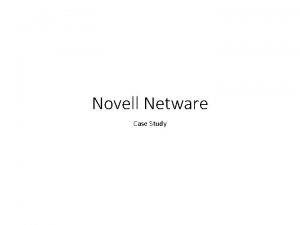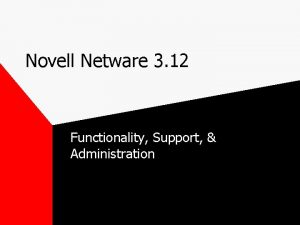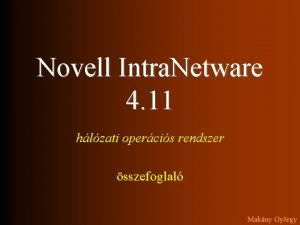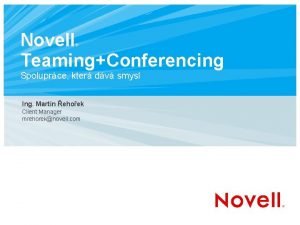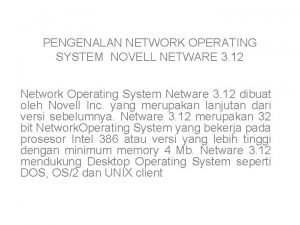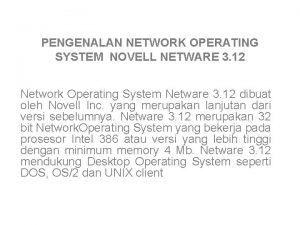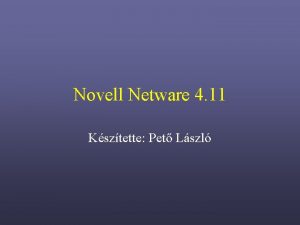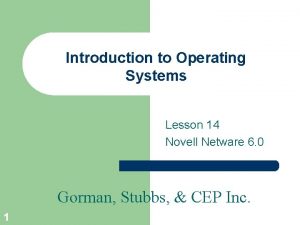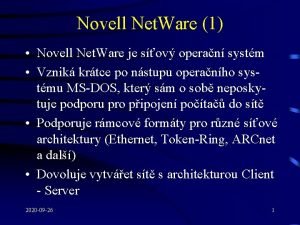Novell Netware Case Study History of Novell Netware











- Slides: 11

Novell Netware Case Study

History of Novell Netware Ø Early on in the rapid expansion of the PC desktop market, it was realized that networking PCs together into a LAN would be a very good thing. It would allow the computing power on those desktops to be used not only to replace the networks of dumb terminals used to communicate with enterprise back-end mainframes, but creating LANs would also give users of those desktop systems a much easier way to share resources, such as files, applications, and printers. ØOne of the earliest vendors to innovate in this market was Novell's first NOS product was called S-Net. ØS-Net was an entirely proprietary NOS, relying on a star-based network whose center element was a specialized computer running the S-Net OS on a Motorola 68000 processor. Needless to say, this solution hardly revolutionized the market.

History of Novell Netware ØNovell quickly realized the inherent limitations of such a solution, however, and released the first product in the Net. Ware line: Net. Ware 86. ØNet. Ware 86 was designed from the beginning to provide a multitasking, centralized file, print, and application server, running on the IBM PC XT with an Intel 8086 processor. ØNet. Ware was, and still is, a custom-designed operating system, specifically written to perform the tasks of a central LAN server. It is not designed (nor is it suitable) for use as a workstation operating system; Net. Ware is a dedicated server operating system.

History of Novell Netware ØNet. Ware immediately provided a huge advantage over the competition at the time it was introduced. ØIt was a multitasking operating system, allowing it to perform as a server for multiple connections at once. Competing products, such as Microsoft's MSNET, could not perform in this role, based as they were upon MS-DOS. ØNet. Ware provided security comparable to that of mainframe systems, with user and group authentication, and file- and volume-level security restrictions.

History of Novell Netware ØWhen compared to the rudimentary (or nonexistent) security implementations of competing LAN NOSs, this level of security proved a real boon to LAN managers. ØNet. Ware rapidly took off and gained dominance over the PC LAN market. To take advantage of improvements in PC hardware architecture, Net. Ware continued to be rewritten and revised to add more functionality.

History of Novell Netware Ø Net. Ware's next major release was Net. Ware 286. ØFor Net. Ware 286, Novell rewrote the OS in 80286 assembly language to take advantage of the performance and architecture advantages of that processor. ØIn addition, a new version of Net. Ware was added to the product line: SFT (System Fault Tolerant) Net. Ware 286. ØSFT Net. Ware was designed to include still more features in a LAN server previously unseen outside the mainframe market: the ability to provide levels of fault tolerance. ØStandard Net. Ware 286 was retitled Advanced Net. Ware 286, and both products were available for some time.

History of Novell Netware ØBy this time, other NOS vendors had risen to the challenge and released competing products to try to reduce Net. Ware's market dominance. ØMicrosoft and IBM collaborated on LAN Manager (or LANMAN) based NOSs, running on top of their multitasking OS/2 operating system. ØLAN Manager-based NOSs enjoyed a great deal of success in many markets (due to the marketing power of Microsoft and IBM, and LANMAN's suitability and performance in some specific network configurations), but Net. Ware's feature set and better networking support helped it continue to lead LANMAN networks by a large margin.

History of Novell Netware Ø Net. Ware's other major competitor at that time was VINES from Banyan. VINES is a NOS based on a highly modified UNIX System V core. ØVINES uses industry-standard internetworking protocols, such as TCP/IP, and as such performed better in integrated LAN/WAN situations than did Net. Ware. ØIn addition, VINES included a directory service by which all network services could be accessed by a symbolic name with centralized management and user login, no matter where their location on the network. ØThese features helped Banyan compete well against Novell in many markets, but Net. Ware continued to lead the market.

History of Novell Netware Ø As the LAN market grew, interoperability between desktop operating systems became more and more important. Ø Novell began to address this issue by adding the ability to serve files and printers to Macintoshes in a release of SFT Net. Ware 286. Ø Novell also tried to take over the peer-to-peer networking market with a product called ELS Net. Ware, which eventually proved to be a market failure. Ø When Intel released the 80386 processor, Novell took a look at their product and made a number of significant changes to it. Ø First, they realized that reliance on assembly language, while providing excellent performance, would make the process of updating their products more and more difficult as hardware architectures advanced and changed. Ø In addition, Novell wanted the ability to port certain Net. Ware services to other platforms to increase Net. Ware's interoperability with other NOSs.

History of Novell Netware ØIn order to achieve this goal, Net. Ware was rewritten entirely in C for the 80386 and released as Net. Ware 386. ØNet. Ware 386 included all the features of Net. Ware 286, including the fault tolerance additions made to SFT Net. Ware. ØNet. Ware 386 also included the ability to more easily design and install add-on products called NLMs (short for Net. Ware Loadable Modules).

History of Novell Netware ØIn order to reduce the confusion inherent in their vast array of products, Novell later merged and retitled their product lines. ØAll versions of Net. Ware 286 were merged into a new version of Net. Ware designed primarily for 80286 processors, called Net. Ware 2. 2. ØNet. Ware 386 became the Net. Ware 3. x series of operating systems. ØELS Net. Ware was scrapped, and Novell released Net. Ware Lite to provide simple peer-to-peer NOS services between workstations.
